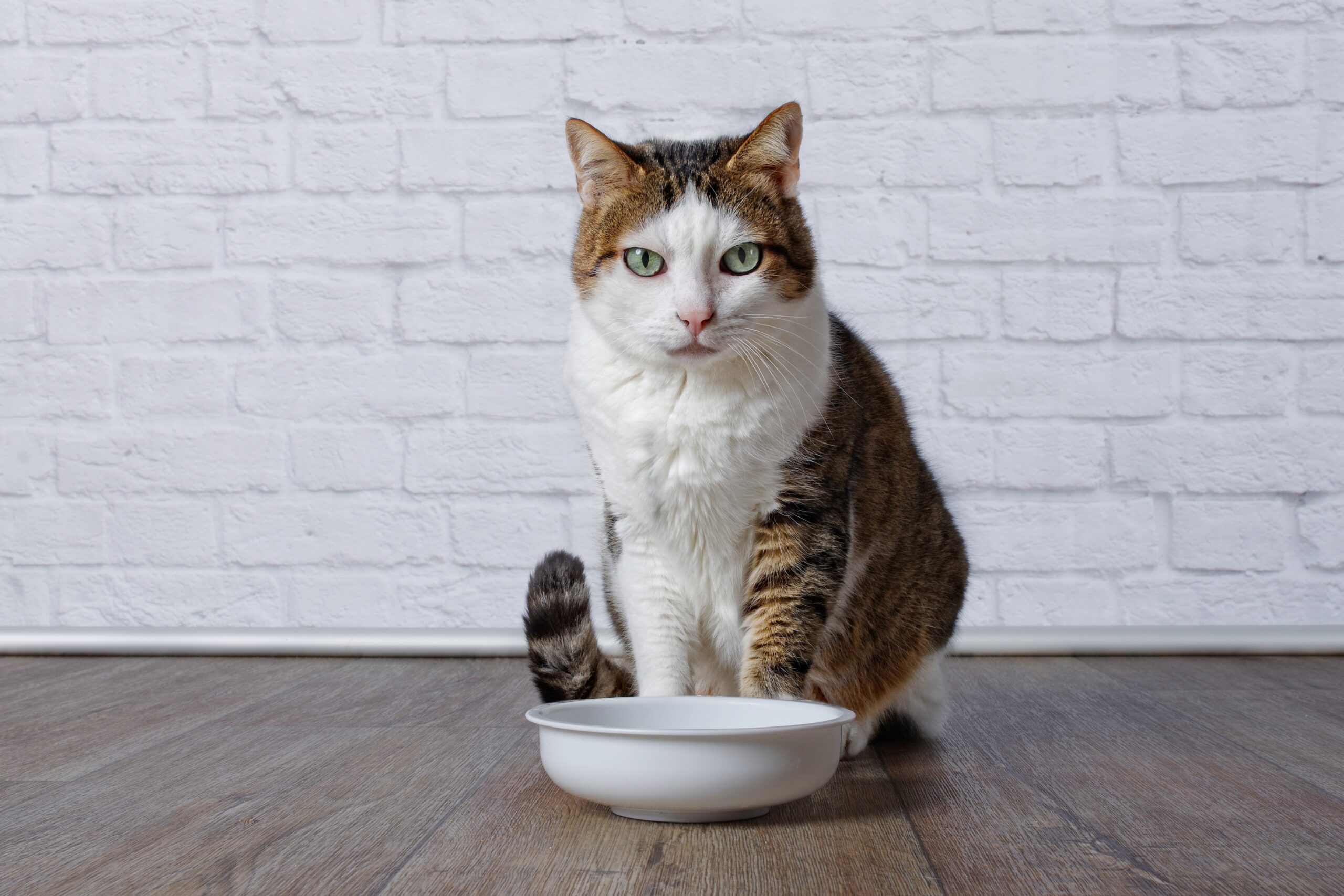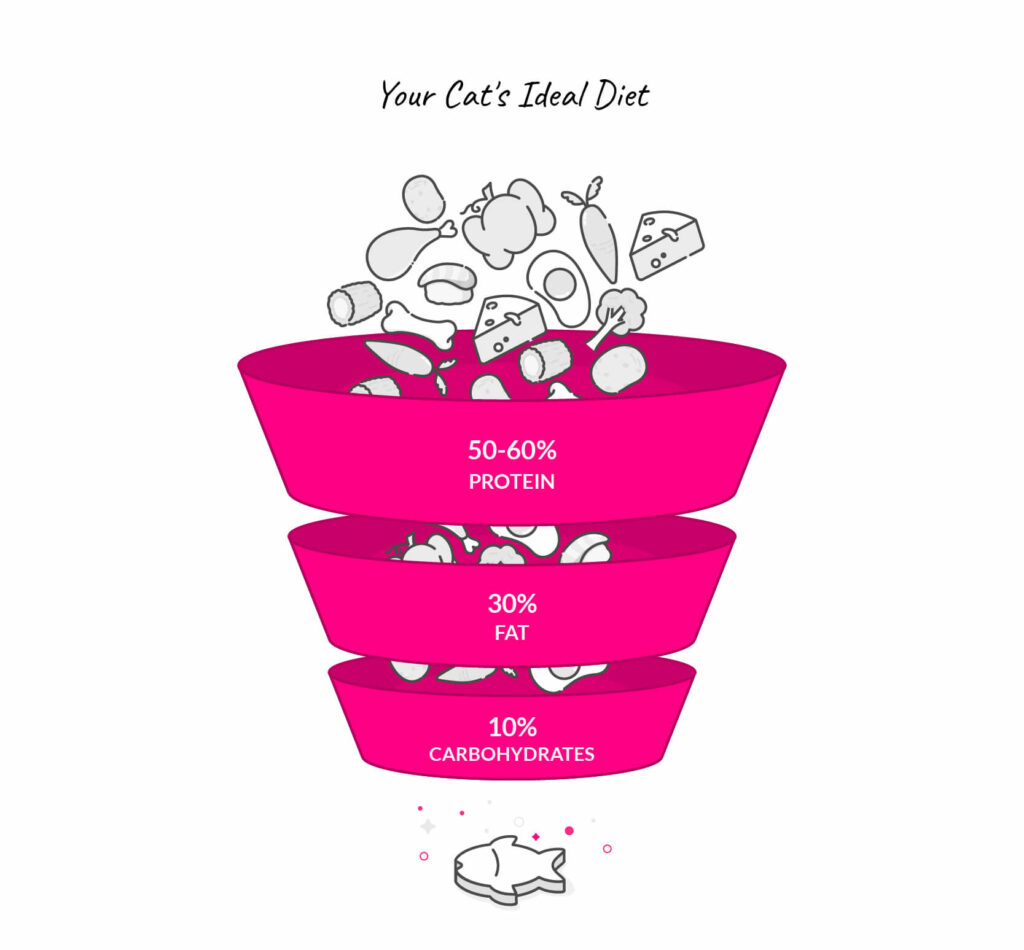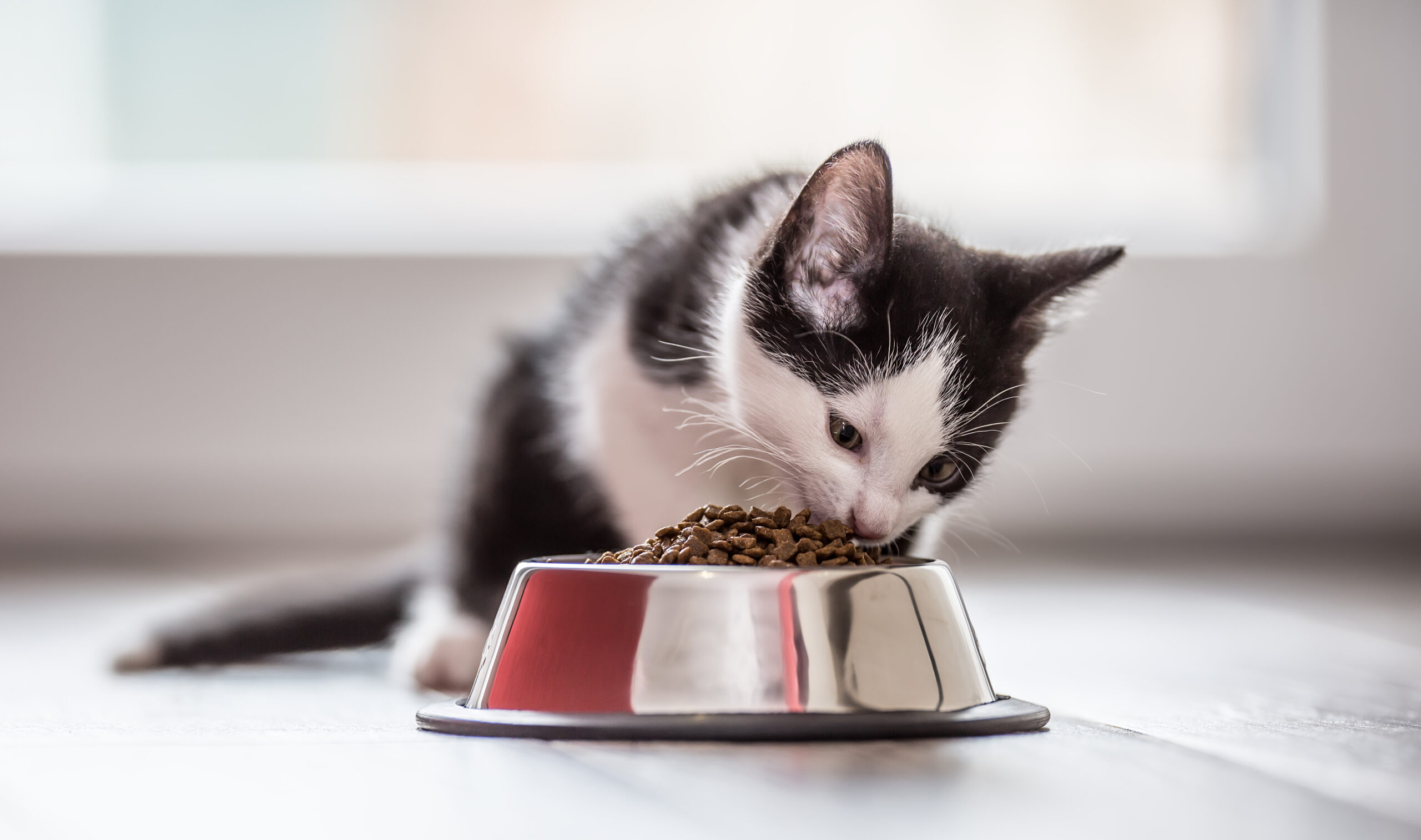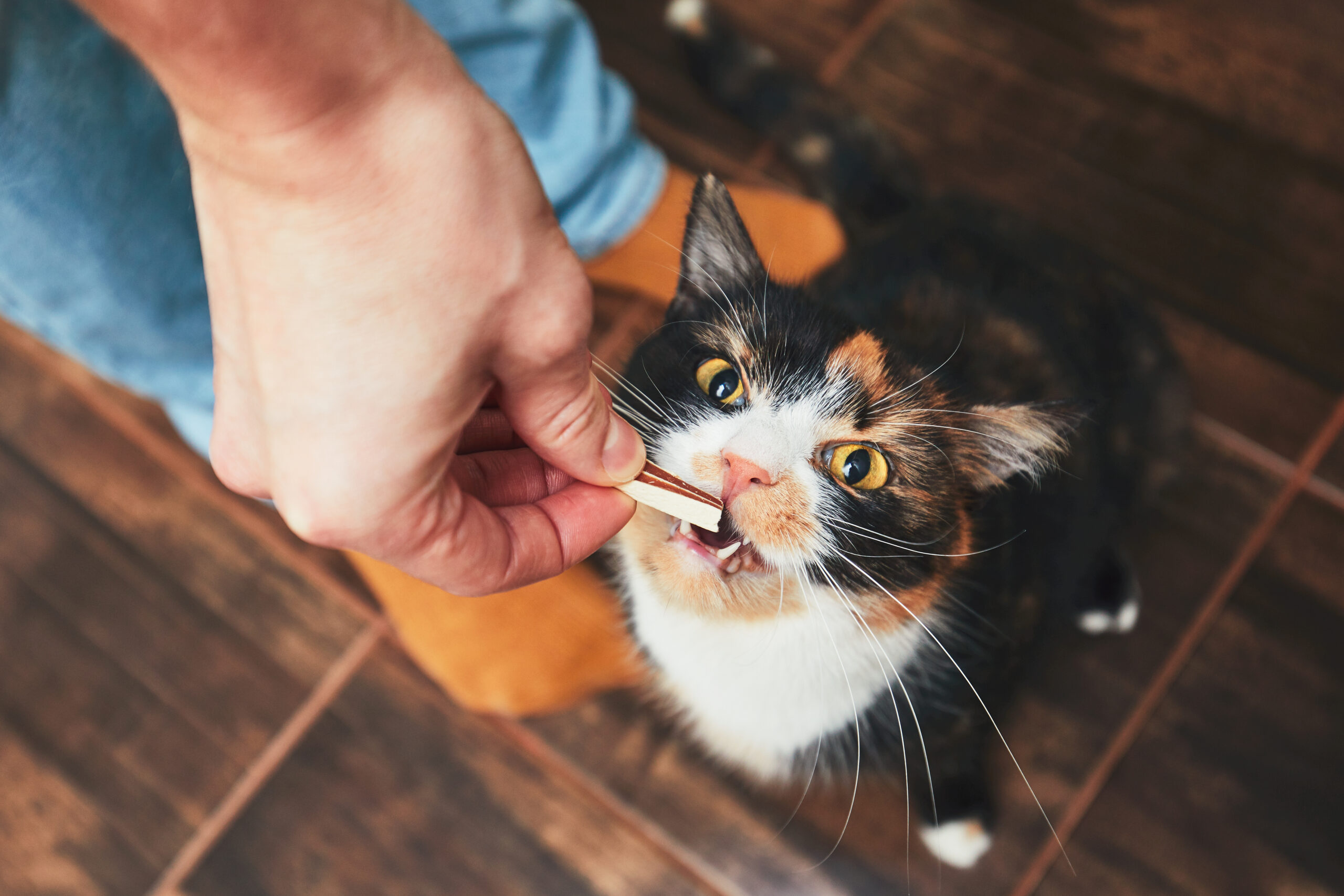Feeding your precious feline can be a daunting task with so many options and opinions out there. Wet food or dry? Is a raw diet an option? And how do you know if your cat’s food is actually high-quality?
We know it can get overwhelming, so we asked the best vet that we know, Dr. Liff, to get to the bottom of all your cat nutrition questions.

What are a cat’s basic nutritional needs?
According to Dr. Liff, you’ll want to have a general idea of how much protein, carbs, and fat your cat has in her diet.
Cats are carnivores, first and foremost, so they really rely on animal products with a lot of protein, moderate fat and minimal carbohydrates. Here’s how to think about the ideal breakdown:
- 50% protein (beef, chicken, turkey, lamb, and fish)
- 30% fat (from meat, dairy, eggs, or plants)
- 10% carbohydrates (from grains, potatoes, or legumes)

If you also have dogs, you might notice that this is a bit different from a canine diet. Cats have high protein and fat requirements—much higher than dogs. Because of this, cats should not eat dog food, and vice versa.
When you’re shopping around for pet food, take a look at the label. You want to look for food that has meat, meat byproduct, or seafood at the top of the ingredient list, says Dr. Liff.
Cats also have 4 amino acids they must eat (and cannot synthesize naturally). These are taurine, arginine, methionine, and cysteine, which come from animal proteins. Make sure you see these fatty acids in the ingredient list in order to prevent any health conditions.
Additionally, you’ll want food with minimal fruits and vegetables (or none at all), because cats struggle to process these. Good cat food brands to look into include Hills, Royal Canin, and Purina Pro Plan.
If you’re interested in doing more research about the wellness of your cat, take a look at the AAFCO website (that stands for the Association of American Feed Control Officials). They will let you know if the food you’re giving your cat is missing any essential nutrients, like phosphorus and omega-3. Also keep an eye out to see if the AAFCO’s official seal is on the packaging of your cat’s food of choice.
Kitten vs. adult cat food
Unsurprisingly, food for kittens is different from what adult cats eat. The goal for kittens is to achieve an optimal growth rate, which is slow and steady. This can be achieved by offering a diet that is specific to kittens, which is higher in protein and fat. Look for quality kitten food that is labeled as kitten food or for growth.
You’ll want to be feeding your fur baby a kitten diet until they’re about 12 months of age.

Dry vs. wet cat food
Every cat is different when it comes to their preferences for dry, wet, or semi-moist food. Dry cat food can be better for oral health, while wet or canned food can be more palatable. Some cats crave one type, while others will prefer a mixture.
Some benefits of wet food:
- Easy to digest
- It’ll help your cat get hydrated—many cats don’t drink as much water as they should
- Cats with sore or missing teeth can chew it easily
- Most felines go wild for the taste
The drawbacks? Wet food can be more expensive than dry. It can get messy. And to human noses, it tends to smell a bit yucky (okay, we’ll be honest—very yucky).
On the other paw, here are some of the benefits of dry food:
- Cheaper
- Convenient—you can leave it out all day for grazing, or put it in an automatic cat feeder
- Your cat’s oral hygiene will benefit. Dry kibble can scrape plaque off your pet’s teeth as she chews
Some of the drawbacks are that dry food isn’t as palatable, contains more grains, and is more likely to contain preservatives compared to wet food. Also, dry food generally isn’t nearly as hydrating as wet food.
Can cats eat “people food”?
Most cats start acting super sweet and flirtatious when you take your plate of food to the dinner table. They might start pawing you, or giving your ankles aggressive head bumps.
It’d be nice if all this affection was a reward for being such a good pet parent—gratitude for the fact that you work hard to provide for your kitty. But no. It’s your food. They just want your food.
But can cats eat so-called “people food”?
First of all, you have to make sure that you know which foods are poisonous or irritating to cats. Here’s the no-go list: Onions, garlic, chocolate, caffeinated drinks, alcohol, grapes, raisins, and macadamia nuts. Another no-no: Dairy products! Most cats are lactose intolerant; those charming cartoon images of milk-slurping felines are built on lies.
But some cats can safely share people food, like a nice piece of fish or chicken, provided it’s made with minimal spices (or even better, without much seasoning at all). Some cats might enjoy fruits and veggies—like Mauri, who is obsessed with cucumbers—but serve them carefully and in moderation. Most felines have a hard time digesting fruits and vegetables.
Are raw food diets healthy?
You’ve probably noticed a growing trend of raw pet food. But are these supposedly “ancestral” diets actually better for your cat’s health?
Dr. Liff isn’t the biggest proponent of raw food. The cats we have in our homes have evolved from those that live in the wild and thus have different lifestyles and different requirements, she explains. Also, our domesticated cats live longer than wild cats previously lived, and some of that is due to the improvements in nutrition that we see with commercially available diets.
With that said, some pet parents keep their cat on a raw diet and have a perfectly healthy and happy kitty. But there is no peer-reviewed evidence to suggest any benefit from raw diets, and there is some high-quality evidence to dispute the value of raw diets.
Whatever you decide, your main concerns should be avoiding possible bacterial contamination, and ensuring the quality of all ingredients.
How much, and how often, should you feed your cat?
We wish we had a simpler answer here, but there is no ideal formula for how much and how often to feed your cat.
You’ll want to feed your feline for optimal growth, or to maintain optimal body weight. This will differ from cat to cat. For example, some cats have more sensitive stomachs than others and will require different quantities and a totally different feeding schedule than others.
How much and how often you feed your cat also depends on their age and overall health. Kittens have different percentage requirements for nutrients (as we’ve already discussed above) and may benefit from more frequent, smaller meals to help with growth and the maintenance of blood sugar.
On the other end of the spectrum, senior cats might need to switch up their diet when they get older. Elder cats often move less which means they have lower caloric needs than younger cats.
While some cats may prefer grazing on dry food all day long instead of regular meals, you’ll want to keep an eye out for your cat’s waistline if you’re free-feeding dry kibble, since this habit can lead to obesity. (As humans trying to avoid snacks in the office, we can relate.)
What about cat treats?
Of course you can give your adorable little monster a treat here and there. They’re especially useful when you’re training your pet. But snacks and treats should never exceed 10% of their total caloric intake daily, Dr. Liff explains, so don’t go overboard. Some good brands to buy are Greenies, Chewy, and the freeze dried meat treats from PureBites.

What about a vegetarian diet?
The short answer is: Not a good idea.
We realize this can be a controversial topic, and there are a lot of passionate and conflicting opinions out there. But here’s our take.
Cats really require animal-based proteins since they have specific, amino acid-based nutritional needs that cannot be achieved by eating plant-based protein alone. They are what’s known as obligate carnivores, so vegetarian diets are not usually complete and balanced for cats (without adding in specific animal protein supplements, which sort of defeats the point).
You could compare feeding a cat a plant-based diet to feeding a cow a meat-based diet. Your cat’s digestive system just isn’t geared to handle it. While you may happily thrive on falafel, tofu, and Impossible Burgers, your feline friend will struggle without meat in her diet.
One last thing
Every pet parent wants nothing more than to see their little fluffball happy and healthy—which can get quite pricey. High quality, store bought food can be expensive, not to mention any of the new direct-to-consumer subscription services for extra-fancy felines.
But feeding your cat right will likely keep medical costs down in the future. And investing in pet health insurance for cats will also help take the bite out of any vet bills.
Lemonade offers customizable, fully digital pet insurance to cover your cat (or dog) from accidents and illnesses. Click below to get started!




